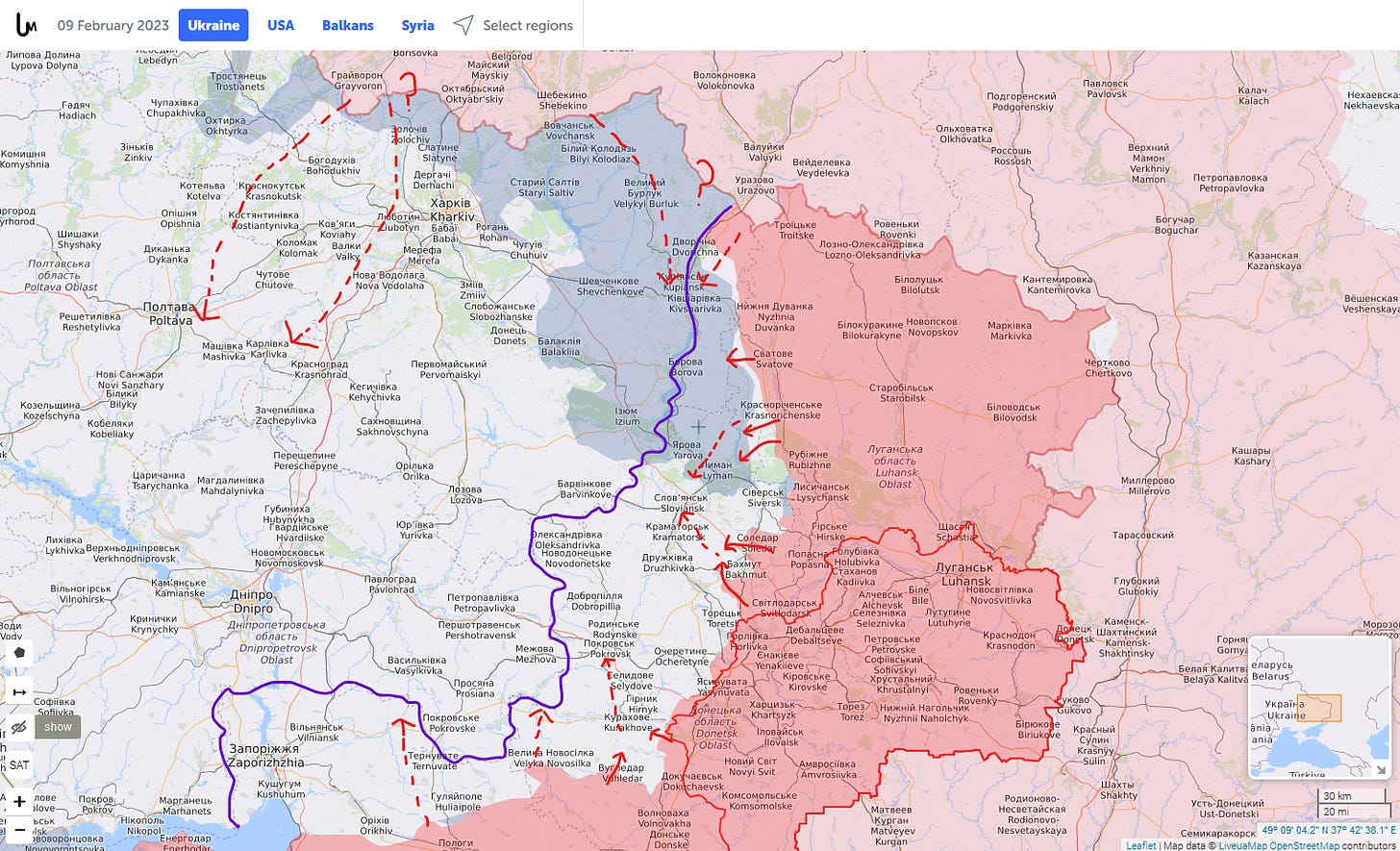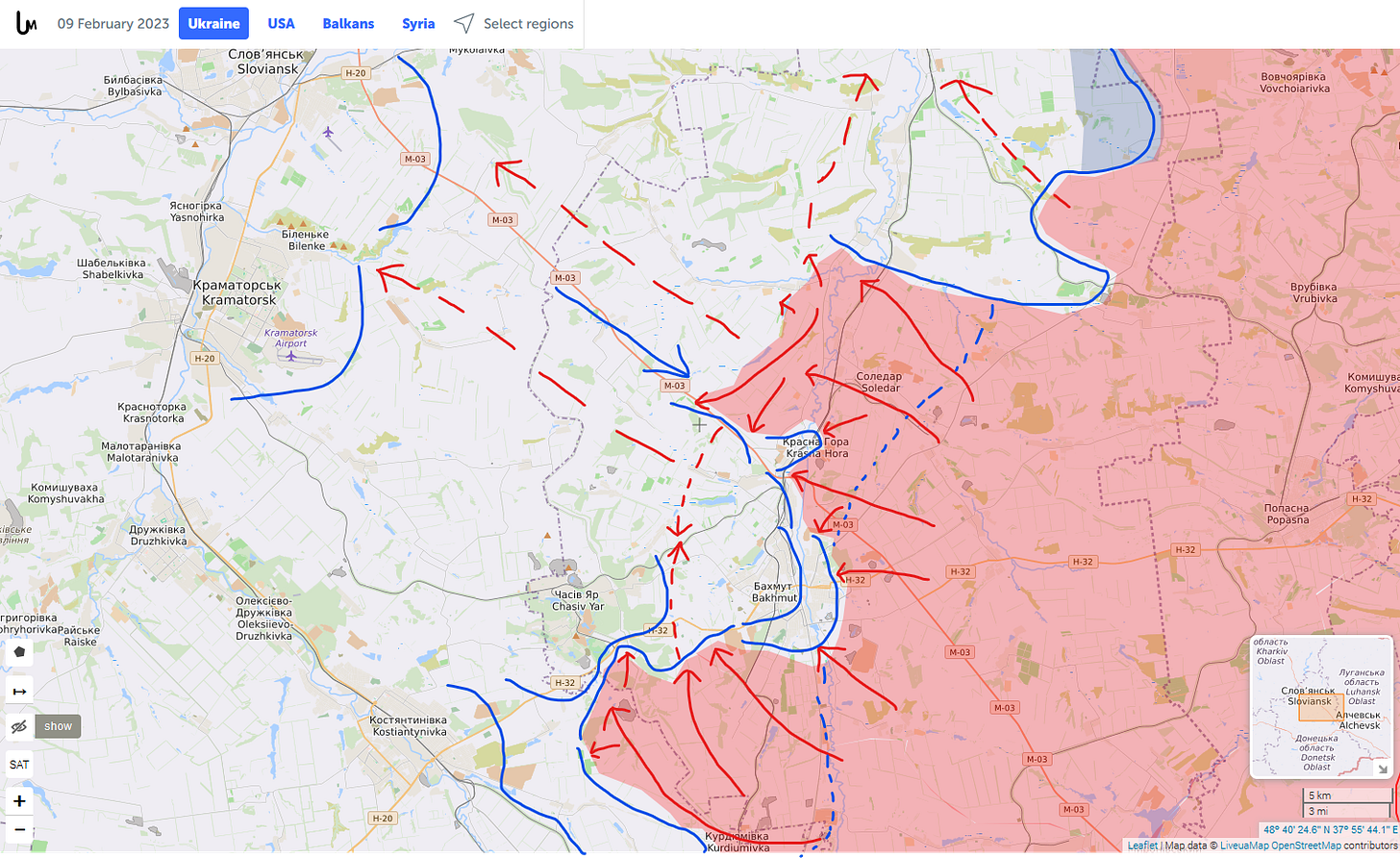The Next Russian Offensive Has Begun
Ukraine will almost certainly win, but the costs will be high
Putin’s winter offensive appears to be underway in Ukraine.
Over the past few days, attacks at many points along the front lines appear to have intensified from probes by infantry squads to battalion or even regiment sized assaults.
At present, it looks as if Russia is steadily ramping up the intensity of operations in Lyman, Vuhledar, and Bakhmut. The goal of these attacks are likely to cut off and surround portions of the Ukrainian front line, if they can, or at the very least fix them in place and wear them down.

Good information is always hard to weed out from the propaganda, but the most reliable open source information from groups like Oryx, Militaryland.net, Rochan Consulting, and Liveuamap.com, taken as a whole, can be used to paint a fairly accurate portrait of what is happening on the ground. Reuters and to a lesser extent AP are mostly reliable, BBC is too though you have to watch the pro-Ukraine slant there.
For the record, sources to be extremely skeptical of include the Institute for the Study of War, Michael Kofmann from the Center for Naval Analyses, and the UK Ministry of Defence. Analysts in the US media ecosystem willingly participate in what NATO terms information warfare, defined in their own documentation as follows:
What is information warfare? Information warfare is an operation conducted in order to gain an information advantage over the opponent. It consists in controlling one’s own information space, protecting access to one’s own information, while acquiring and using the opponent’s information, destroying their information systems and disrupting the information flow.
Controlling one’s own information space, from the NATO perspective, involves participating in a peculiar team narrative where all players are expected to toe the line that NATO unity is everything and Russia is losing no matter the facts on the ground. NATO leaders want to keep their citizens on side, and are willing to lie to them if necessary to advance the greater good.
The problem with this approach is that science shows that activities like this undermine your own side as much as it does your opponent. It’s a recipe for groupthink, a social phenomena where people form tribes that fight to defend a particular narrative about themselves, rejecting contradicting information.
Russia’s assault on Ukraine failed in large part because of groupthink: accepting without question the ridiculous notion that Ukraine wouldn’t fight back. However, NATO groupthink has led to Ukraine not receiving the full spectrum of arms it needs to liberate territory Russia has taken, meaning the war is unlikely to end any time soon when it could have, as I’ve been arguing for several months now, been nearly over already.
Fortunately the open source intelligence community is able to commit to higher standards, even while actively supporting Ukraine’s self-defense. Strangely, Ukraine itself has proven to be a generally reliable source, mainly omitting unpleasant or sensitive details as opposed to lying about a situation or spinning it.
All in all, it is clear that Russia has initiated a major strategic operation designed to reverse its battlefield fortunes. By spending four months training up a cohort of draftees held back from the front and likely outfitting them with renovated gear Russia’s industry has been fighting to field, Russia has probably produced a sufficient reserve of combat power to begin advancing on one or more fronts.
So far, Russian forces have only intensified assaults in areas they were already conducting operations:
The Lyman-Kreminna axis has seen Ukrainian advances towards the latter halt, while Russian reinforcements have begin to strike through the open country away from the Siverski Donets River towards Yampil. Their goal is likely to restore the previous Russian line along the river in order to help put pressure on Siversk and Sloviansk. They could also help Russian forces push Ukraine’s brigades back towards the Oskil river, away from Kreminna.
In the open country around Vuhledar, in the south of Donetsk, Russia has been making concerted efforts to push across a water boundary and into the rear of a brigade holding a salient to the east. One battalion had a very bad day, losing a couple dozen vehicles, but further west Russian forces punched several kilometers past the defensive lines around Vuhledar, which could allow another attack near Marinka to punch down the highway and surround thousands of Ukrainian defenders.
And around Bakhmut, Wagner cadres are being replaced by Russian regulars hwo appear to be giving Ukraine’s defenders a very hard time. Southwest of the city, a Russian pincer is running into several brigades dug into the high ground. To the north, though, a recent breakthrough threatens Ukrainian forces holding Krasna Hora and the approaches to Bakhmut city. It could also allow Russia to push towards Siversk in conjunction with the attacks towards Lyman. Ukraine has deployed a brigade held in reserve to stop this advance, meaning it won’t be available to plug holes elsewhere.

Unfortunately, Russia does not yet appear to have committed all of its new reserves to the fight. It seems that Russian attacks are meant to steadily intensify, drawing in Ukraine’s reserves. This will leave it open to another major blow from an unexpected direction, east or perhaps even west of Kharkiv.
Supposedly, Gerasimov, the commander of Russia’s invasion, is a big fan of Second World War history. If that is true, I have to imagine his pride as an officer taking his place in the annals of war will allow a simple bloody grind to the administrative borders of Donetsk and Luhansk.
Likewise, Putin is unlikely to be able to declare this a sufficient victory to justify the cost. A sequence of operations meant to rip Ukraine into pieces before an assault on Kyiv in late 2023 or early 2024 is Putin’s probable intention now.
Estonian intelligence suggests that Russia has amassed a force around twice as large as the one it used to hit Ukraine last year. Ukraine’s mobilization has made it much stronger than it was, but the pain it is suffering from this unending struggle is real.
Fortunately, Ukraine has the ability to trade space for time, bleeding the Russians as they advance until the mud of April bogs them down. In mid or late June, modern arms should be on the ground in sufficient number to power a swift, vicious counterattack that stands a real chance of breaking the Russian army.
But before then, a long and bitter struggle awaits Ukraine’s defenders.



